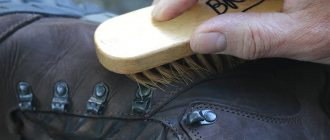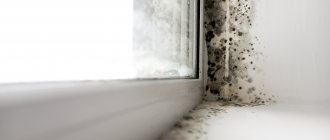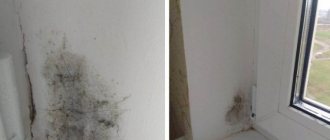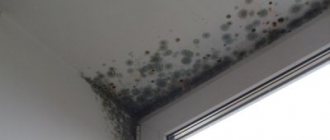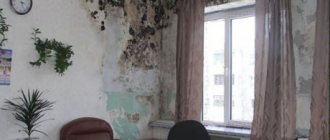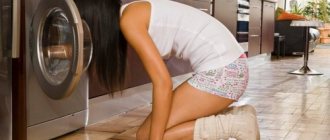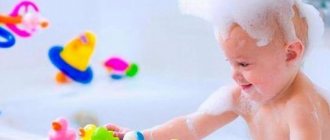How dangerous is black mold in the house for the human body and how to get rid of it is a complex question that worries many people. After all, some residents have to periodically deal with the appearance of black mold fungi in their own apartment or private house. It is extremely unpleasant to see colonies of fungi on products that have been lying on the shelf for a long time, or on the walls in the bathroom and other rooms.
This problem should be dealt with immediately, because mold provokes various diseases in family members. However, it is not possible to do this quickly in all cases, but you also cannot leave the problem without a solution. In order to find the best way to get rid of the scourge, we will look at the dangerous consequences of fungi, what types most often appear in apartments and how to deal with them yourself.
How dangerous is black mold in the house for the human body and how to get rid of it?
What is mold and why is it harmful?
The mold that we see in our homes is a fungus. It develops from a spore.
A spore is a microorganism protected by a durable shell. The mold that develops from it is a multicellular organism formed by long fibrous threads (hyphae). Moreover, it grows from the spore at high speed, “capturing” the surrounding surface.
A mold spore is a microscopic, single-celled capsule with a tough shell.
Nature has made sure that spores can withstand difficult conditions; they are carried with air currents and cling to objects. And for mold to begin to grow from this “capsule”, certain favorable factors are needed, which we ourselves create in our homes:
- Increased air temperature (many people like to warm themselves and turn on heaters).
- Increased humidity (for example, in a bathtub, where clothes are often dried for a long time, puddles remain on the floor after bathing, floor mats are not dried, etc.).
- Lack of access to fresh air (insufficient ventilation of premises).
Mold loves a moist environment and multiplies quickly there
Various types of mold can grow on almost any surface: concrete, wood, paper, fabric, food. The fungus especially likes to settle next to plastic windows, because condensation sometimes accumulates there. Over time, mold can destroy the walls, ceiling, and floor of a room.
Types of black mold plaque
Black mold is considered the most dangerous to humans. It often causes the development of serious illnesses. There are several types of microorganisms that lead to the appearance of black deposits on surfaces in residential areas.
Aspergillus black fungus
This microorganism is a saprophyte that lives in conditions of high humidity. They are a black coating. It most often occurs on walls and ceilings in bathrooms, kitchens, toilets and swimming pools. They can form colonies in air conditioners and even washing machines. These microorganisms release a large number of spores, which quickly scatter throughout the room due to this mold. Clothes, furniture, books and other items may be affected.
These fungi can cause the development of meningitis, bronchial asthma and myocarditis. Inhalation of large quantities of fungi can cause severe poisoning. Aspergillus nigra often leads to the formation of pulmonary aspergilloma.
Aspergillus fuming fungus
This microorganism is highly resistant even to strong temperature changes. This mold gets its name from the fact that it causes black wool to appear on the surface, and when touched, a smoke of spores appears.
Fungi can survive at -53°C. Most often they infect vegetables and fruits, but they can also establish colonies on surfaces in residential areas. The toxins produced by these organisms are extremely dangerous. They can suppress the immune system and destroy red blood cells. Inhalation of spores can cause aspergillosis.
Alternaria alternata fungus
This mold produces large numbers of spores as it grows. Colonies of these fungi appear as flat spots of dark gray or black color with a greenish tint. Most often, this mold parasitizes on dead plants, but it can also appear on other surfaces. When growing on grains, toxic substances released by this microorganism can poison the product, making it unfit for consumption. This fungus can provoke bronchial asthma and dermatitis.
Methods of infection of the body: through food, air in the room and direct contact
Mold can penetrate the human body and cause various problems there in various ways:
- Air route. Mold spores are suspended in the air. They easily enter the human respiratory tract and then “travel” throughout the body. Moreover, spores are powerful allergens.
- Eating moldy foods. Of course, if there is mold in the product, this becomes immediately clear from the characteristic smell. However, some people are in no hurry to throw away such food, but simply remove the spoiled layer from the bread or cut off the green pulp from the fruit. This cannot be done, because the mold fibers go deep inside, although this is not visible from the outside. As a result, a person gets food poisoning, sometimes very severe (intoxication of the body occurs).
- Touching mold. When human skin comes into contact with mold, mycoses (a type of skin disease) can occur, this is especially likely if the immune system is reduced. Not only the upper layers of the epidermis are affected, but also the subcutaneous fat. Fungi can go further, causing diseases of muscles and bones, penetrating into internal organs.
Toxins
Mycotoxins have systemic effects (headache, fatigue, etc.) and local (irritation of the eyes, skin, lining of the nose and bronchi). Their local actions also disrupt the barrier functions of damaged body tissues, which increases the penetration of allergens and infections, leading to more frequent illnesses from both allergic and infectious and even malignant diseases.
In extreme cases, high concentrations of mycotoxins in the air can cause a serious toxic reaction. Contact with materials containing mycotoxins may cause skin rashes.
Symptoms such as eye, nose and upper respiratory tract irritation, fatigue, cough and chest tightness are often related to the presence of glucan (a bioactive carbohydrate in the cell wall of mold) in the air.
A number of forms release mycotoxins (fungal toxins). These are:
- Aspergillus versicolor - can be found in house dust on the floor;
- Chaetomium globosum - mainly found on wood and cellulosic materials;
- Stachybotrys chartarum - Found primarily in damp drywall.
Mold Dangers to Pets and Houseplants
It turns out that mold is harmful not only to people, but also to other living inhabitants of a private house or apartment. We are talking about indoor plants and pets.
Thus, an insidious fungus more often than usual affects flowers that do not require intensive watering, and therefore are not able to absorb a lot of moisture at once (for example, cacti, aloe, violets, “money tree”, etc.) At the same time, mold can attack both soil and and the plant itself (in this case, the leaves begin to rot, turn black, and curl).
Mold can affect both the indoor plant itself and the soil in which it grows.
Of course, mold affects the plant negatively:
- Deteriorates soil quality. It disrupts water and mineral metabolism, acid-base balance.
- Death of the plant. The top layer of soil can turn into a crust that retains moisture and does not allow air to pass through. The roots begin to rot, then the branches and leaves die.
- Mold can “move” onto the windowsill, window frames, walls, and ceiling.
As for pets, if they inhale spores or tactile contact with mold, they may experience breathing problems (including pulmonary edema) and disruptions in the functioning of the nervous system. In case of severe poisoning, death cannot be ruled out.
If spores of certain types of mold enter the body of a weakened animal (for example, an old animal or a pet after an injury), then the fungus can affect internal organs.
The effects of mold on the human body
Exposure to mold is harmful to the human body because it produces and contains toxic compounds that are hazardous to health. A person can inhale mold spores with air, and they will settle in the lungs. Also, fungal spores easily get into food and are absorbed through the skin, which is why nails are checked in swimming pools for the presence of mold under them.
Sometimes after brushing your teeth, a specific taste appears in your mouth, this indicates that fungus has appeared on the toothbrush and it should be replaced immediately. Mold causes allergic reactions in children, since the children's immune system is not yet strong enough. Since everyone's susceptibility to mold fungi is different, the consequences of infection can also vary significantly. Elderly people and patients who have undergone chemotherapy and are taking antibiotics are especially susceptible to severe illness due to exposure to mold.
Diseases resulting from mold exposure:
- Pneumonia;
- Sinusitis;
- Skin rashes;
- Dry cough;
- Stomach upset;
- Nosebleeds;
- Headache.
The cause of these diseases is sometimes very difficult to diagnose and difficult to cure. Many types of mold that surround us have pathogenic forms, long-term exposure to which can cause internal bleeding, liver and kidney damage, as well as pulmonary emphysema. Severe mold poisoning of a person leads to the development of mycosis, which is diagnosed in various laboratories and allergy centers using test tests.
What to do if mold appears on food
As a rule, mold can appear suddenly and anywhere; it can especially often be found in your own refrigerator on food. Most often, mold appears on baked goods, and upon discovering such a surprise, many simply cut off the mold-affected area, mistakenly considering the rest of the bread to be edible. Basically, no one even thinks about how safe such actions can be for the health of the whole family. So what should you do with moldy bread?
Modern scientific research has shown that dairy products and flour products affected by mold should definitely be thrown away entirely, since they have a porous structure through which mold spreads calmly and unhindered, penetrating the entire depth of the product. However, this does not apply to hard cheese; the mold that has formed on it can be carefully cut off with a knife, and the remaining part can be used to prepare dishes such as pizza.
Quite often, mold appears on jam, which is a pity to throw away. It is a mistake to believe that such formations can somehow resemble penicillin. This is not true, because noble mold, which is used to make healthy products, is grown in special conditions and undergoes the necessary preparation, and the mold that affects our products in the refrigerator contains a great variety of toxic substances that negatively affect the human body.
First aid for mold poisoning
If mold does enter the body, it is recommended that in case of poisoning, immediately consume activated carbon, 1 tablet per 10 kg of body weight. With any, even the most minor poisoning, the liver is primarily affected, so you should take this problem seriously. If a sufficiently large amount of moldy product is eaten, it is advisable to rinse the stomach with a weak solution of potassium permanganate or use a medication that has a restorative effect. The best option in case of mold poisoning is to contact a doctor in a timely manner, who will help you correctly carry out the procedure for removing toxins from the body.
I was faced with a problem that was not very serious at first glance, suspicious dark spots on the walls. But if you look deeper, such stains that occur in basements, bathrooms or living rooms can lead to significant problems in the future. These are mold fungi, a sign of high humidity and poor ventilation in the room. Mold is a colony of a single-celled fungus that develops from spores that are constantly present in the air in a “preserved” state in huge quantities. The spores “wake up” for intensive reproduction as soon as favorable conditions appear for this: increased humidity and warmth.
How mold spoils walls and other surfaces in the house, basement and how to get it out
As already mentioned, mold does not spare the building materials of the home. Initially, the fungus concentrates on the surface of plaster, brick, stone, and then penetrates inside, destroying the material from the inside, forming cracks.
If the owners notice mold on the ceiling or walls, it must be eliminated immediately. The stages of such work will be as follows:
- The affected area is cleaned of fungus using a sponge or a metal brush (if there is wallpaper on the wall, you must first tear it off, and similarly remove the layer of plaster).
First of all, you need to clean the affected surface from mold using a sponge or wire brush.
- The surface is treated with an antiseptic (for example, Domestos, Biotsid-S, Abedis 06, Olymp Stop Mold, etc.). It should dry for about 4-5 hours (the exact time depends on the temperature and humidity of the room). If the mold damage was very strong, it is better to repeat the treatment after drying.
- The next step is to coat the wall with a primer (it is better to do this twice after the first layer has dried). This will strengthen the surface and enhance the application of subsequent finishing. By the way, you can buy a primer containing components to combat mold (this will enhance the effect).
- At the end, you need to restore the decorative finishing coating of the ceiling or wall (apply plaster, stick new wallpaper).
As for removing mold from wooden surfaces, the same chemicals indicated are used for this purpose. Many also use folk recipes (table vinegar, hydrogen peroxide, tea tree oil, baking soda).
If the fungus has penetrated deeply into wooden furniture, then it is better to simply get rid of it. After all, under favorable conditions, mold will probably return.
Poll: what is the best mold repellent?
Which mold repellent would you choose or recommend?
HG Mold Spray
50.00 % ( 1 )
Dali (Dali)
0.00 % ( 0 )
Bagi Anti-mold
0.00 % ( 0 )
Alpa Phongifluid
0.00 % ( 0 )
Cillit BANG spray Black Mold
0.00 % ( 0 )
Stop-Mold Olimp
0.00 % ( 0 )
Abedis 06
50.00 % ( 1 )
Neomid BIO Repair
0.00 % ( 0 )
Belinka
0.00 % ( 0 )
How to treat clothes, books and furniture against fungus
Often, mold also affects clothing, for example, if it has been stored for a long time in an unventilated room or a closet that has not been opened for a long time.
You can first try to revive such a thing using folk remedies. There are many options here: soda, boric acid, hydrogen peroxide, fermented milk products, lemon juice in combination with salt, table vinegar, ammonia, turpentine, etc. You can try different methods until the desired result is achieved.
Folk remedies can help remove mold from fabric
If the fungus has already become deeply ingrained, then household chemicals that contain chlorine (again, Belizna, Domestos) will come to the rescue. However, you need to remember that for some fabrics such products are unacceptable (for example, for wool it is better to use Vanish).
Mold can also affect books. You can try to get rid of it. The spots are moistened with a solution of 2–3% formaldehyde, and the remaining pigmentation is bleached with hydrogen peroxide.
Mold on a book can be removed with a formaldehyde solution, and then the stains can be bleached with hydrogen peroxide
Before processing, you should place a regular sheet of white paper under the book page. You should wear rubber gloves when working with formaldehyde to protect your skin.
Video: removing mold from a book
Another way to remove mold from books is to rub the stains with boric acid and then dry the pages with an iron.
As for furniture, you need to understand that it is almost impossible to remove mold spores from upholstered furniture. If the upholstery can be washed and treated with antifungal agents, then the batting and foam rubber in the depths of the structure cannot be disinfected in any way. Unless, of course, you are ready to completely remove the upholstery and disassemble the structure, treat the wooden frame, fillers and upholstery separately, and then reassemble it from scratch.
How you can fight mold on textiles and shoes
- Repeated treatment with chlorhexidine,
- hydrogen peroxide,
- Miramistin,
- antifungal sprays such as Miko-stop.
- iron,
How to clean a moldy baby stroller
If mold has formed on a baby stroller during storage, of course, it is better to dispose of it or wash it well and use it only for an older baby, and not for a newborn.
Procedure:
- We remove the inner mattress and sides of the cradle, and the cover-cover. We wash them at the highest possible temperature according to the product passport or replace them with new ones (you can sew them yourself). When washing, add an oxygen stain remover such as Vanisha. After washing, dry and, if possible, steam, being especially careful in the seam area.
- We remove from the frame all the upholstery that can be removed. If it is secured with self-tapping screws or self-tapping screws, unscrew it. If it is possible to remove the bottom of the cradle, take it out. The fabric is usually synthetic, afraid of chlorine, but not afraid of oxygen agents and short steaming treatment. Soak for an hour, wash thoroughly, dry, and gently steam.
- We wash and treat the bottom of the cradle. Let's dry it.
- We wash the stroller chassis, dry it, and go through it with a steam cleaner.
- When everything is dry, we assemble the stroller.
How to get rid of it: effective methods
Mold has appeared on the wall in the apartment: what to do? Before you start using various drugs and remedies, eliminate favorable conditions for the active functioning of the fungus. Having destroyed the uninvited guests for a short time without performing the necessary manipulations, the mold will again settle in the house.
Destruction of favorable conditions
Recommendations:
improve heating. Make sure that radiators and other heating devices heat the entire room, and not a separate object (move them away from the sofa, wall, place them so that warm air blows into the space)
It is important to ensure that the room is heated evenly; do not keep the bath closed; if this room is not heated, the likelihood of mold growing increases;
provide high-quality thermal insulation. Main problem areas: joints between walls and floors, ceilings, doorways, window perimeter
Cracks are formed as a result of non-compliance with construction technology and cosmetic work;
improve ventilation in the house. Walk around the apartment with a candle, if the fire does not move in the direction of the ventilation holes, then clean them and correct the problem immediately. Also check the neighboring apartments; it is likely that the problem lies in their ventilation;
Eliminate sources of water leakage. Seal the pipes and change the finishing material around this area. If this is not possible, then dry the surfaces with an industrial hair dryer and treat with an antiseptic;
fight capillary moisture. It oozes from neighbors or through finishing material from the street. Waterproofing walls and ceilings will help fix the problem; pay special attention to water pipes;
get rid of hydrophilic materials in rooms with high humidity. Such items can be products made from fabrics or wood; remove them from the bathroom, if possible from the kitchen, replace them with hydrophilic products made from modern materials.
Having followed all the necessary recommendations, you will immediately feel an improvement in the microclimate in your home, and your health will also return to normal.
Fighting fungal colonies
Now start fighting the fungus directly in the apartment mechanically using a variety of means
Recipes:
antiseptic primer. It is easy to find in any hardware store, use Stop-mold, Alpa, Dali and others. Their use will help not only destroy existing fungal colonies, but also prevent the reappearance of uninvited “guests”
It is important to thoroughly clean the wall before processing; if necessary, remove all finishing material down to the brick;
There are bleaches in every home, they do an excellent job not only with stains, they quickly kill mold, and are an excellent alternative to professional products. Do not use the preparations on all surfaces; some of them will be impossible to restore later.
Bleach is allowed to be used on bathroom tiles, the bathtub itself, and glass surfaces. Disadvantage of this method: bleaches are not effective on drywall and wood. Wear gloves during the procedure, dilute bleach with water in a ratio of 1:10;
vinegar, hydrogen peroxide, ammonia. These remedies for mold on the walls in the apartment have destructive power; they are used together with water in equal proportions. Treat the desired surface with the resulting raster, do not wash off. To obtain the desired result, repeat the manipulations several times.
tea tree oil. It is the safest remedy for humans, but destructive for mold. Take a teaspoon of ether per glass of water, place the solution in a spray bottle, and treat the desired surface. Pleasant aroma, absence of fungus - guaranteed.
Prevention
Of course, mold in the house, like any problem, is easier to prevent than to deal with it later:
- Ventilate the room regularly.
- Maintain a normal level of humidity in your home. For the warm season it is 65%, for the cold season it is 60%. You especially need to take care of the bathroom: after taking a shower or bath, you should leave the door open for some time, it is better to dry your clothes on the balcony.
It is very important to maintain optimal air humidity in the room.
- The temperature in the apartment should not be too high (optimally 20–22 °C).
- When a water leak occurs, you not only need to fix the problem quickly, but also dry the wet area as quickly as possible.
- Clean the house more often, get rid of garbage and junk.
My history
For many years we lived in an apartment whose walls were covered everywhere with black fungus. In the first years, this problem did not seem so global to us, and we did not particularly try to solve it. Of course, even a good renovation quickly ceased to please the eye, the wallpaper simply fell off, all this blackness did not look aesthetically pleasing, but tolerable.
Things put away in the closet were completely saturated with an unpleasant putrid odor, which could not be eliminated either with washing powder or with the help of perfume and cologne. Time passed, and living side by side with such an unpleasant neighbor took its toll.
Folk methods of struggle
The most commonly used means for eliminating mold are:
- Table vinegar (undiluted). The substance should be applied to the affected surface from a spray bottle or washed with a cloth soaked in vinegar. If necessary, repeat the treatment 2-3 times.
- Baking soda. Can be used as a solution of 1 liter of water and 2 tbsp. l. soda or rub the surface with soda paste. A good effect is achieved by using vinegar and soda at the same time: first you need to pour dry soda, and spray vinegar on top - during the reaction of the two components, fungal spores will be destroyed. These safe products will help get rid of mold in the bathroom, in the living room, and even in the refrigerator if the unit has suddenly become a breeding ground for fungus.
- Hydrogen peroxide (3%). The pharmaceutical preparation should be applied to the surface affected by mold and left to act for 10-15 minutes. Peroxide will perfectly eliminate fungal colonies in tile joints, under old wallpaper, on the lid of an aquarium and in other places.
- Ammonia or medical alcohol. It is recommended to spray the walls or ceiling with a spray bottle or with a sponge soaked in the selected preparation. Leave for about an hour so that the active substance has time to destroy visible traces and invisible mold spores.
- An aqueous solution of copper sulfate. For the desired effect, you need to dilute 100 g of the drug in 10 liters of water. The resulting solution can be used to treat any surface, but it should be taken into account that they will turn blue.
- Bleach and other household chemicals with chlorine (Belizna, Domestos, Santry). Can be used concentrated or diluted with water. Products of this type are suitable for treating walls before finishing work, as well as for soaking clothes and textiles with signs of mold.
- Tea tree or grapefruit seed essential oil. Suitable for surfaces with a slight degree of fungal damage. 20 drops of an aromatic substance should be mixed in 0.5 liters of water, poured into a spray bottle and generously moisten the affected surface with this solution. After drying, the solution does not need to be washed off - it will create a protective barrier that prevents the development of mold in the future.
After cleaning with improvised means, treated walls or ceilings must be rinsed with clean water to remove any remaining fungus and active ingredients.
When working to eliminate black mold, you must wear safety glasses, gloves, and a respirator. This measure will minimize the harm from inhaling spores. The remaining rooms must be insulated by sealing the entrance to them with any sealed material.
This is what protective equipment should look like during antifungal treatment of a room
